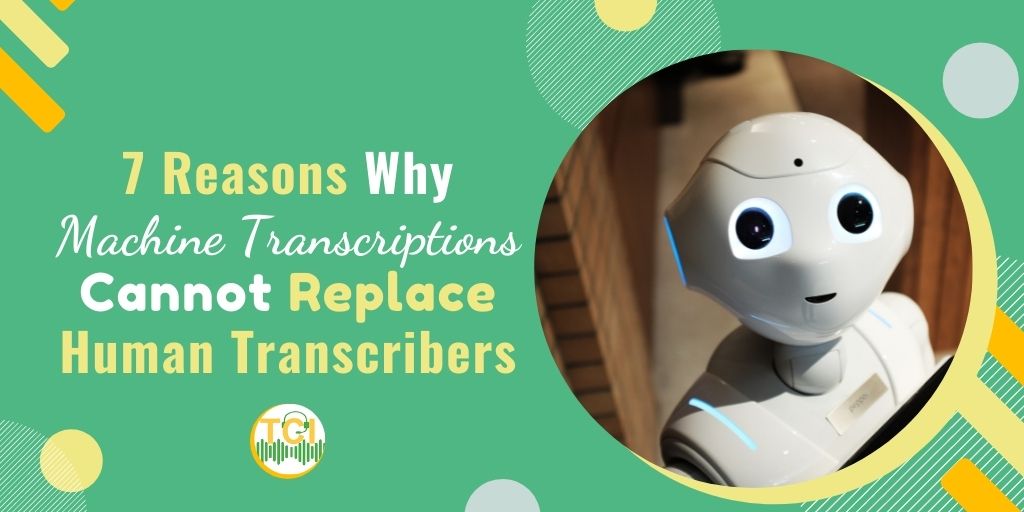
Technology will take over human-centric jobs so we can focus more on what we’re best at - being creative. Businesses are constantly leveraging technology to get challenging tasks done and save costs on training while meeting deadlines.
However, technology is best suited to replace monotonous tasks. When it comes to overtaking creative roles, nothing beats human intelligence. Machine transcription is one example that highlights how human creativity is still far from being replaced by machines.
Even though you will find a wide range of speech recognition tools in the market, they fail to match the expertise of manual transcription. Most businesses that still opt for machine speech recognition devices do so to amplify their productivity and get more work done in half the time.
While debating over machine transcription vs. human transcription, businesses might prefer machines if they prioritize quantity over quality.
The truth is, machine transcription becomes a liability in the long run rather than an asset.
Machine transcription processes audio files into text within seconds. However, they still haven't learned to differentiate noisy background noise from actual speech. So, it’s generally best for the audio to be recorded in quiet environments. The machine will transcribe every audible noise if you work around busy areas.
However, despite the audio quality, humans can differentiate between noise and speech and create professionally transcribed documents with minimum errors.
If the audio files feature conversion among several speakers, it gets overwhelming for the machine to understand. It's more challenging when the speaker speaks in different languages. These machines still do not possess the skills to understand discussions between multiple speakers and consequently transcribe the entire speech as if it came from one person.
Human transcribers can easily understand a discussion, and their intelligence can detect different speaking tones, accents, and speakers.
Humans are trained to differentiate between different subjects and use their expertise, emotional intelligence, and experience to produce error-free transcribed documents effectively. Machines, however, are set to do just what they are programmed to do – transcribing audio files without understanding their relevance, context, or deeper meaning.
In non-verbatim files, machine transcription is useless, and they can't add appropriate phrases or words by themselves to make more sense to the readers.
Machines generate words by listening to the audio files playing for them. They can't understand the context of the discussion. Speech recognition software depends on sentence structure to predict verbiage. This can often result in creating inaccurate transcripts as they might use homonyms whose meanings differ from the actual context.
However, humans would first understand the context of the words before using them. Therefore, they would use words that resonate with the audience, even when several words sound similar.
Different audio would often come with different accents. For machines to learn all the accents, it can take several years, which is not cost-effective. In contrast, human intelligence can distinguish between different accents and write them down comprehensively without formal training. Therefore, speech recognition software struggles to give a sensible output if it encounters strange accents.
However, humans are continuously exposed to varying accents and dialects which enables them to create nearly error-free transcripts, regardless of the speakers’ accents.
When machines hear words they don't know, they try to convert the word to something closest to their vocabulary or skip it completely, citing inaudibility. However, you don't have to worry about missing out on words with humans.
Humans can immediately understand slang by researching and spelling it correctly in the document.
Machines are great with punctuation, but they don't stand a chance compared to human expertise. A machine may assume a pause in between audio at the end of a sentence. However, in reality, the speaker might be giving a little thought before extending the sentence or sipping their coffee.
Such errors in judgment can result in a transcript with several grammatical mistakes and create a transcript that is nonsensical.
Also Read: The Power of Punctuation
Professional human transcribers are the future of the transcription industry. Only a human can understand the emotions and intent of another. A machine can keep learning but can't match the expertise of a human transcriber. Humans can interpret body language and expression while the machine takes it as silence. For companies valuing quality over quantity, the human transcriber is the key to success.
Your TRANSCRIPTION CAREER CAPSULE to Help You BOOST Your Potential
Latest Industry News, Jobs, Tips and More..

Comments are closed